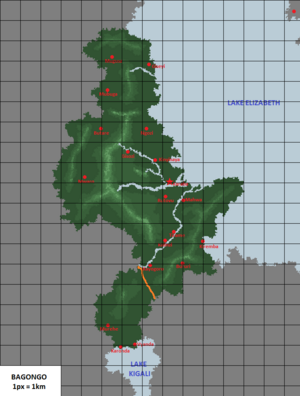Second Bagongo War
This article is incomplete because it is pending further input from participants, or it is a work-in-progress by one author. Please comment on this article's talk page to share your input, comments and questions. Note: To contribute to this article, you may need to seek help from the author(s) of this page. |
| Second Bagongo War | |||||||
|---|---|---|---|---|---|---|---|
| Part of Afruikan conflicts, Butu-Miyazenga conflict | |||||||
 | |||||||
| |||||||
| Belligerents | |||||||
|
Bagongo People's Party Various Butu militias |
Umbumwé Bagongo Freedom Party Bagongo Legitimist Party CUAW Various Miyazenga militias | ||||||
| Russel Financial (secretly) | Palmyrion | ||||||
| Commanders and leaders | |||||||
|
|
| ||||||
| Units involved | |||||||
|
BLDF 1st Kigali Division 2nd Luga River Division 3rd Mahwan Division 4th Karaban Division 5th Mugusan Division BPVA BADF 1st Aviation Regiment 2nd Aviation Regiment Air Defence Forces |
FROLIBO 1st Infantry Brigade 2nd Infantry Brigade 3rd Infantry Brigade 4th Infantry Brigade Presidental Guard Battalion 15th Combined Arms Battalion Mahwa Self Defence Battalion Kayogoro Self Defence Battalion Keremba Self Defence Battalion | ||||||
| Casualties and losses | |||||||
|
100s killed 1,000s captured Some wounded | Light casualties | ||||||
| ~40,000 civilians killed | |||||||
The Second Bagongo War is an ongoing military conflict in Bagongo, with some minor spillovers into neighbouring countries in Afruika. It started in August 2019 after the shootdown of a plane carrying Bagongolese President Michael Zuluka, killing him and many other Butu government officials. Zuluka's successor, Arthur Bukenya, accused the Miyazenga-dominated rebel group FROLIBO, led by ousted President Paul Mugerwa, of having conducting the attack. Several days afterwards, Butu child soldiers stormed the National Assembly during an emergency session and massacred dozens of Miyazenga politicians. The government then ordered the beginning of a mass genocide against the Miyazenga, with thousands being killed by soldiers and Butu militias, ending the peace brought about by the OAC-mediated Gola Accords in 2017 after the First Bagongo War. The conflict continues to escalate.
Background
After the conclusion of the Second World War in Afruika, Bagongo became a trust territory of the World Assembly. After gaining independence, King John I of the Miyazenga Nyanza dynasty ruled the country. A wave of ethnic violence with the majority Butu targeting the Miyazenga minority broke out, resulting in many deaths. John I was eventually deposed in 1985. After becoming a republic, the political system of the country was marred by electoral gridlock and more violence. In 1998 Colonel Paul Mugerwa led a military coup against the government, declaring himself President of Bagongo. His rule brought about a period of stability and economic development for Bagongo, but heavy favoritism for the Miyazenga. When Mugerwe began to move against the special interests and foreign corporations operating in the country, a colour revolution rocked Bagongo in 2012, forcing him to flee the country.
The Butu politician Michael Zuluka took control in place of Mugerwe, but fell under the influence of his Vice President, Arthur Bukenya, a man well known for his hatred of the Miyazenga. Meanwhile, Mugerwe regrouped with loyalists in the border regions of Yughana and in 2014 formed the Front for Liberation of Bagongo (FROLIBO). The same year he launched an offensive into Bagongo from Yughana, seizing a huge amount of territory east of the Luga River, an area that is home to a large percentage of the Miyazenga population. Due to a mass exodus of Miyazenga military officers to Mugerwe's side, the Bagongoese military found itself incapable of launching counter-attacks. The frontline eventually stalemated and in 2017 the Organisation for Cooperation in Afruika brokered a cease-fire in the city of Gola, named the Gola Accords. Both sides agreed to hold free elections, resulting in a new two-party system, dominated by the Butu-dominated Bagongo People's Party and Miyazenga-dominated Bagongo Freedom Party.